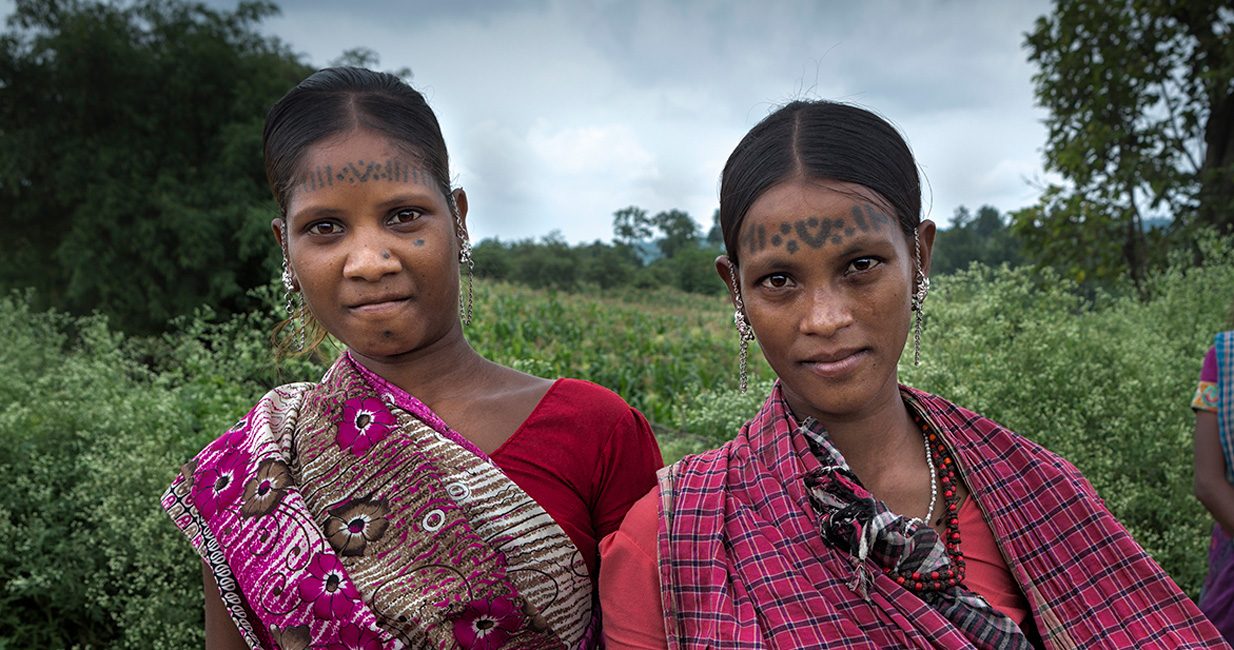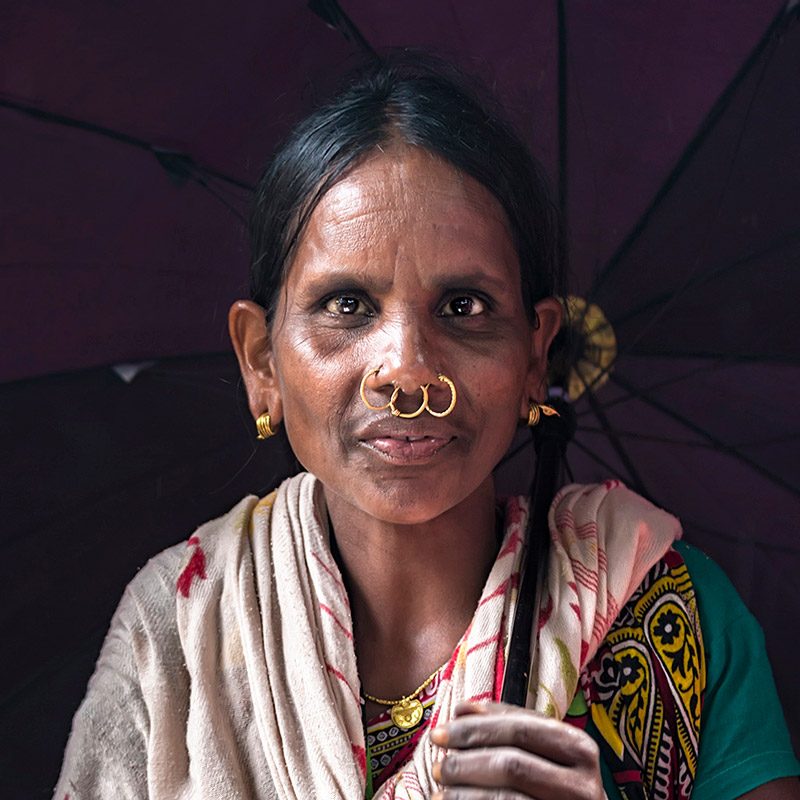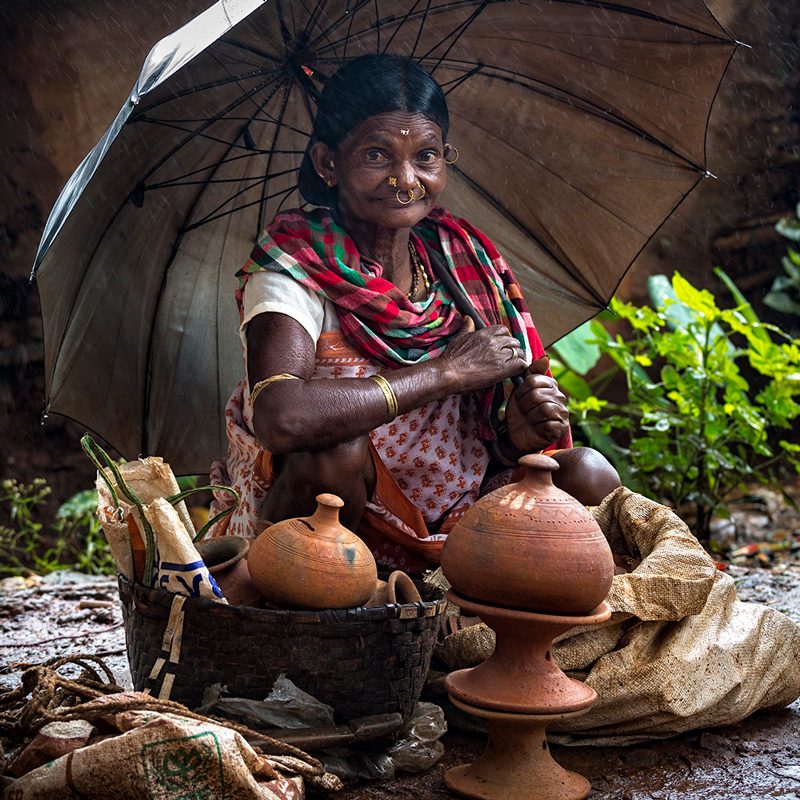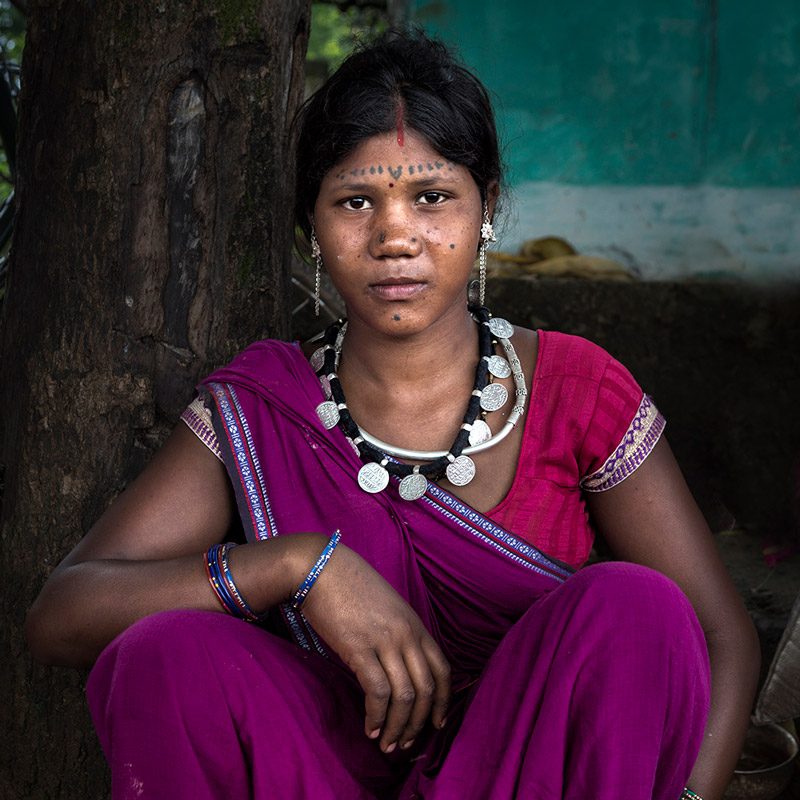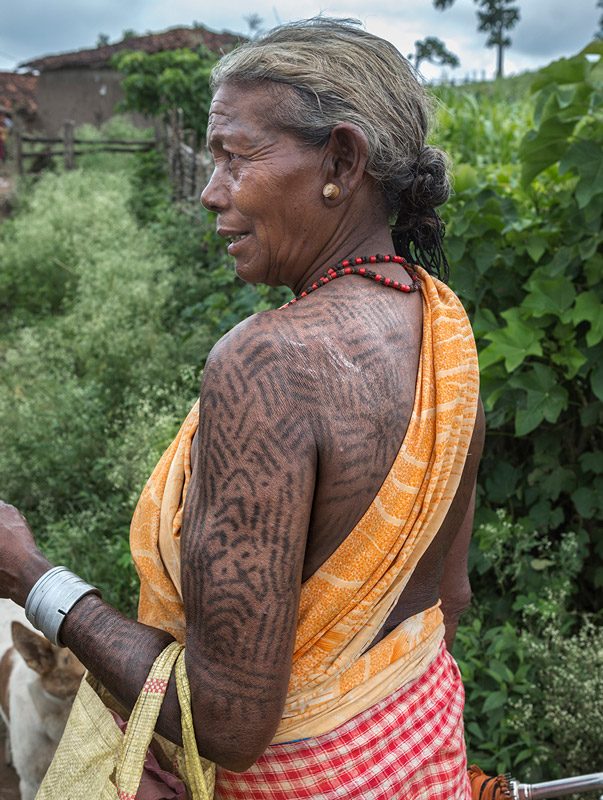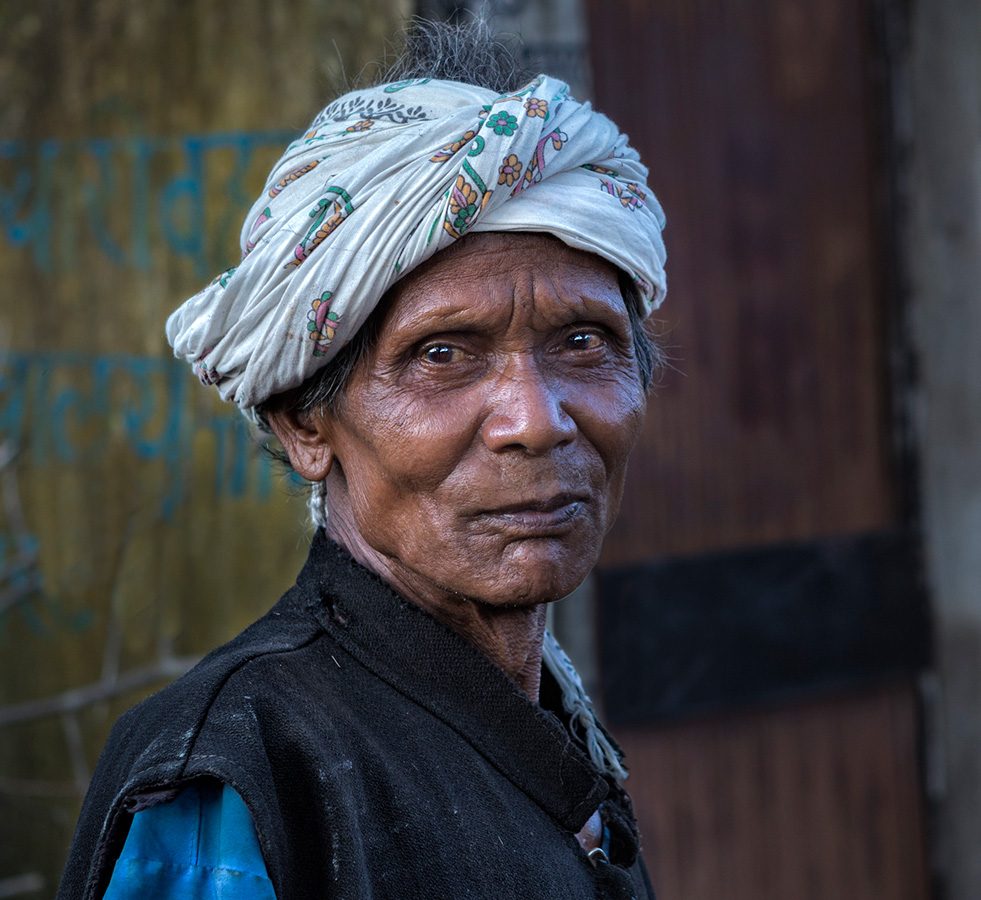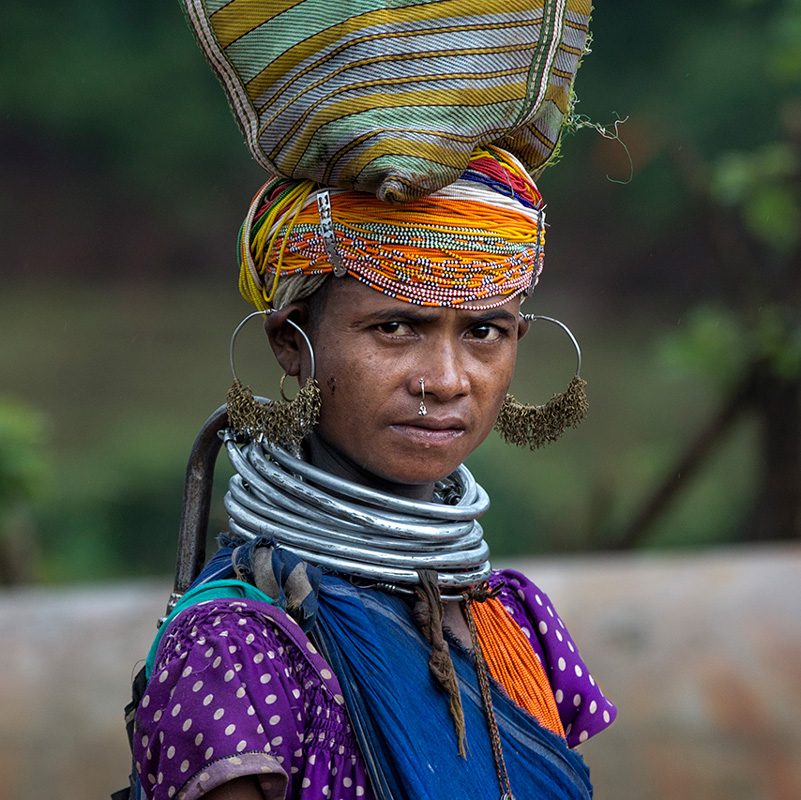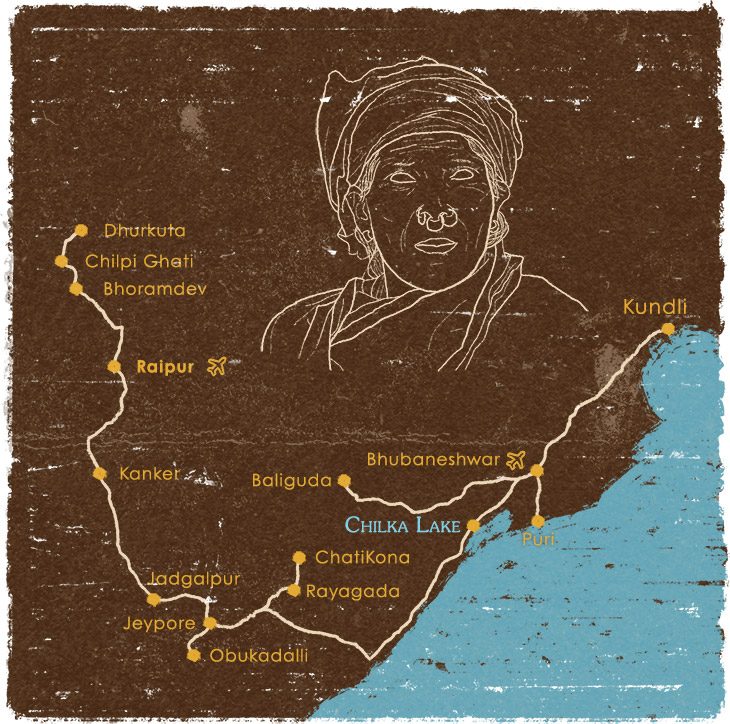Discover the highlights of this trip to India
► We will meet tribes from different regions of India
On this trip to India, we will have the opportunity to meet tribes from the regions of Chattisgarh, Bastar and Orissa. We will visit the markets of Dhurkuta, Kondagaon, Dandamai, Chatikona, Koraput and Kundli, where we can meet different ethnic groups. Likewise, we will stop in some tribal villages.
Baiga tribe
The Baiga tribe is an ethnic group from the Chhattisgarh region that stands out for its magnificent tattoos. This farming group practices crop rotation, called “bewar” or “dahiya.” Live-in relationships are common among the Baiga. If marriage does take place, the man compensates the woman’s family for the loss of a working member. This reverse dowry either involves footing the bill for the marriage celebration or offering the woman’s family mahua liquor. If divorced, the new husband must compensate the old one for the dowry amount. In the case that the divorced couple have children, the wife has the first right, followed by the husband. f neither wants to raise the child, the community will assign a guardian to the child until age 15.

Dongria Kondh tribe
On this trip to India, we will have the opportunity to meet the colorful Dongria Kondh tribe at their market in Chatikona. The Dongria live in villages scattered throughout the hills. They believe that their right to cultivate Niyamgiri’s slopes has been conferred on them by Niyam Raja and that they are his royal descendants. They have expert knowledge of their forests and the plants and wildlife they hold. From the forests, they gather wild foods such as wild mango, pineapple, jackfruit, and honey. Rare medicinal herbs are also found in abundance, which the Dongria use to treat a range of ailments. Dongria Kondh families often spend days in their orchards, keeping animals at bay with songs and drumming. hey also cultivate orchards in the forest, producing crops such as oranges, bananas, ginger, sweet papaya and the aromatic resin jhunu, all of which are sold at local markets.A recent study found that the Dongria gather almost 200 different foods from their forests and harvest over a hundred crops from their fields. This amazing diversity sustains them year-round, with little need for food or goods from beyond their hills. The tribe also keeps chickens, pigs, goats and buffalo. Dongria men gather juice from the forest’s giant sago palm trees, a drink that provides energy for the long hikes they make throughout the Niyamgiri Hills.

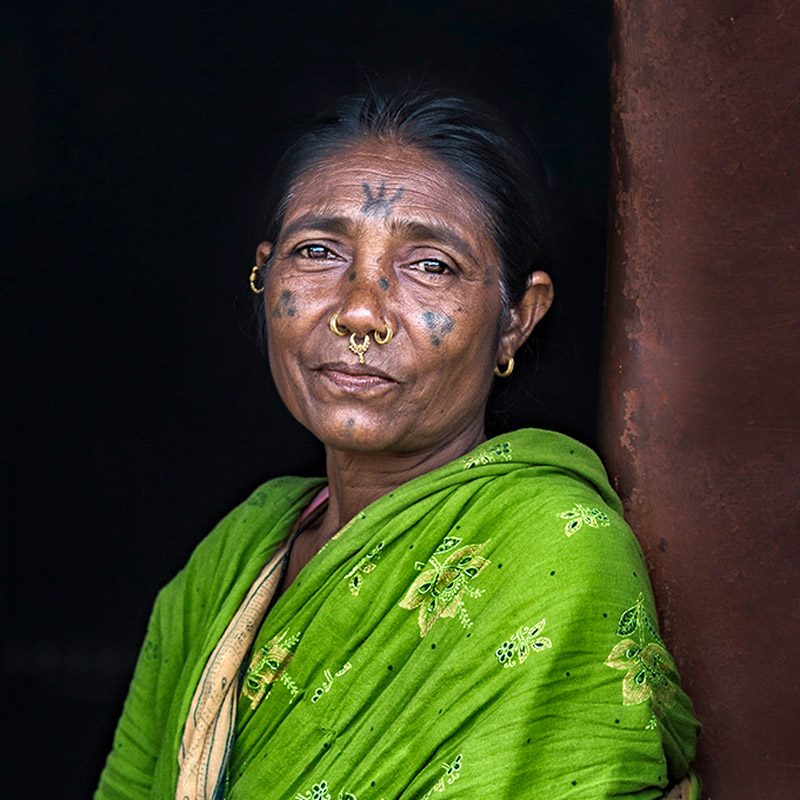
Khond tribe
The Khond tribe are an indigenous Adivasi tribal community in India. Traditionally hunter-gatherers, they are divided into the hill-dwelling Khond and plain-dwelling Khond. All the Khond identify by their clan and usually hold large tracts of fertile land but still practice hunting, gathering and slash-and-burn agriculture in the forests as a symbol of their connection to and ownership of the forest. Khond speak the Kui and Kuvi languages and write them in Odia script. They are adept land dwellers, exhibiting greater adaptability to the forest environment. However, due to development interventions in education, medical facilities, irrigation, plantations, and so on, they are forced into the modern way of life in many ways. Their traditional lifestyle, customary traits of economy, political organization, norms, values and worldview have drastically changed over a long period of time.Bonda tribe
During this trip to India, we will visit the weekly market of Onkadelly with the aim of meeting one of the oldest tribes in India, the Bonda tribe of Orissa. The Bonda live in the isolated hill regions of the Malkangiri district of Odisha. There are two different Bonda tribes: the Upper Bondas with a population of 6,700, who are the most isolated from mainstream Indian society, and the Lower Bonda with a population of 17,000. Upper Bondas have almost no connection to the outside world.Bonda boys are expected to marry between the ages of 10 and 12. A form of dowry (known as Gining) is paid for brides. Divorce, also known as “Lung Sisi” is also an issue among the Bonda people. In some extreme circumstances, such as if a Bonda woman is divorced for adultery, the former husband demands double the price that was paid for their marriage. When death or mora occurs, it is customary to sacrifice a cow on the tenth day, a practice also known as “Gaitang”.
The Bonda women are the primary workers and providers of food for the community. This matriarchal dominance is also seen in the marital norms of the community. Bonda girls largely marry boys who are at least five to ten years younger than them. Thus, the girl looks after her husband as he grows up, and in turn, he cares for his older wife. The women traditionally wear neck rings, which are about 500–700 grams each and cannot be removed without the help of a blacksmith. A woman traditionally wears a two-piece dress that is very colorful, that is woven by the women themselves.
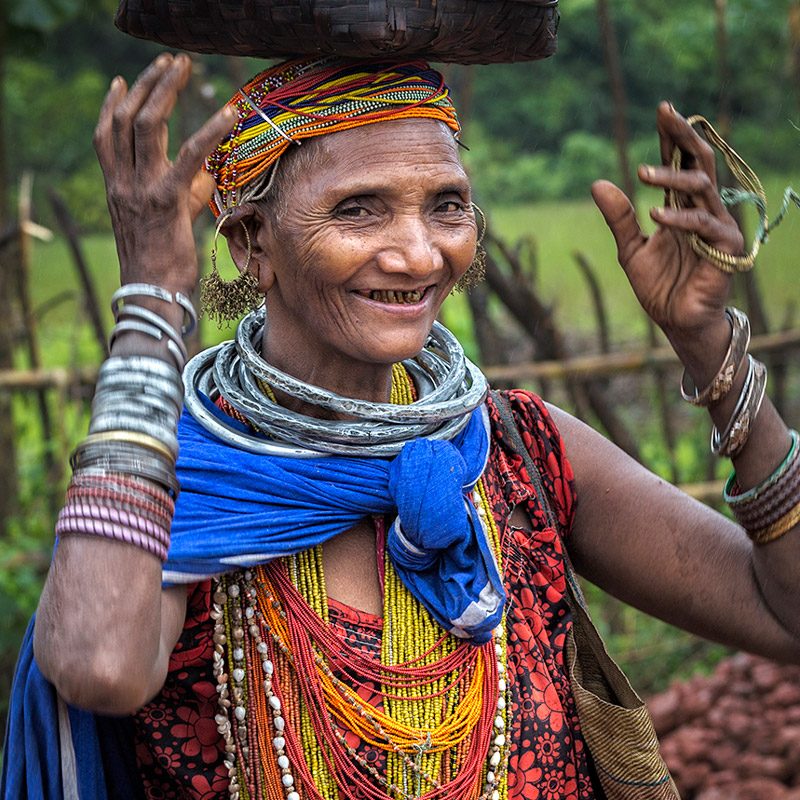

► We will visit different religious temples in India
Throughout this trip to India, we will admire beautiful temples of different religions, such as the Keshkal Shiva temple, the Jagannath temple in Koraput or the Bhoramdev temple, known as the “Khajuraho of Chhattisgarh”, and famous for its captivating complex of Shiva temples from the 11th century.
Sun God temple
On this trip to India, we will visit the Konark Sun God Temple, which was built by King Langula Narasimha Deva in the 13th century AD, during the golden age of Orissa art. his temple, among the crowning works of Orissan architecture and sculpture, is sheer poetry in stone. Every day the Sun God rises from the prospect, across the shimmering blue waters of the Bay of Bengal, and casts the affection and fluorescence of his revitalizing rays on the sacrarium sanctorum, which surrounds the temple during the course of the day, illuminating the three brilliant images of the sun - in the morning, at midday and in the evening. As you approach the water, you will see rising from the golden sandy beach one of the country’s most vivid archaeological treasures, the Surya Mandir (Sun Temple). For a millennium, this temple served as a beacon to the ancient and medieval mariners. Despite the fact that it lies in ruins, the structure is magnificent.Peace Pagoda
During this trip to India, we will visit Dhauli, where the Mauryan monarch Ashoka repudiated violence and embraced the teachings of Buddha. We will visit the Peace Pagoda, known as the Shanti Stupa built in the early 1970s by the Japanese. Also, we will stop at two venerable rock edicts, today overshadowed by the presence of the Pagoda. Dating from 260 BC, they outline Ashoka’s accurate instructions to his administrators to rule with gentleness and fairness.Bhubaneshwar Temples
Bhubaneswar is the capital of the antediluvian kingdom of Odisha (Orissa), and is famous as the temple city of India. Travel through Odisha (Orissa) is a hodgepodge of art, domicile and long-established customs. On this trip to India, we will tour the city with the aim of admiring some magnificent temples that gather around Lake Bindusagar. Of the original 7000, only 500 remain, dating from the 7th century to the 11th century AD. Of these, the most outstanding is the 11th century Lingaraja Temple , which celebrates the meridian of Odisha (Orissa) art; and the late 10thcentury, beautifully decorated Muktesvara Temple, which marks the end of the phase of temple building in Odisha (Orissa).Outside the city limits are the Udayagiri and Khandgiri caves, harking back to the time of Jain and Buddhist occupation of this region in the 2nd century BC. The Jain caves are among the earliest in India, and all the caves were built or shoveled during the 150 years before Christ. In opposition to the stark decor of the Jain caves, the Buddhist caves are decorated with excellent friezes and sculptures.
© Photos by Ana Robles taken during a trip to India.
► Book your place now for this trip to India
Click on the button below to easily reach the form to book your place for the trip to India.

